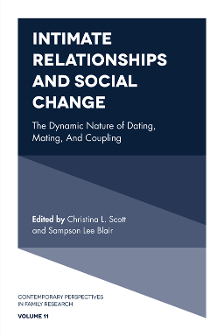
Index
Intimate Relationships and Social Change
ISBN: 978-1-78714-610-5, eISBN: 978-1-78714-609-9
ISSN: 1530-3535
Publication date: 4 September 2017
Citation
(2017), "Index", Intimate Relationships and Social Change (Contemporary Perspectives in Family Research, Vol. 11), Emerald Publishing Limited, Leeds, pp. 267-272. https://doi.org/10.1108/S1530-353520170000011014
Publisher
:Emerald Publishing Limited
Copyright © 2017 Emerald Publishing Limited
INDEX
- Prelims
- “Enjoy the Heat of a Log, and Heed the Advice of the Elders”: Religious, Educational, and Neighborhood Determinants of Parental Influence on Spousal Choice in Nepal
- “…And Here We Are…”: Influencing Factors of Intimate Partner Preference Among Married Couples in Nigeria
- Intergenerational Conflicts and Resistance of Daughters in Suburban Turkey
- Changing Gender Role Expectations in the Family Formation Process Through the Lens of Ambivalence
- Educational Assortative Mating and Female Breadwinning Trajectories: A Group-Based Trajectory Analysis
- Dating & Mating in Adolescence: A Model to Predict Pathways of Relationship Outcomes
- The Transition to Adulthood in Individualistic and Collectivistic Cultures: Prevalence and Timing of Premarital Cohabitation and First Marriage in Germany and China
- Marriage and Cohabitation Among Rural and Urban Women in Western Mexico
- Living Apart Together Relationships in Later Life: Constructing an Account of Relational Maintenance
- Technology Use and its Association with Romantic Relationships
- The Aftermath of Dating Relationship Dissolution in Emerging Adulthood: A Review
- About the Authors
- Index